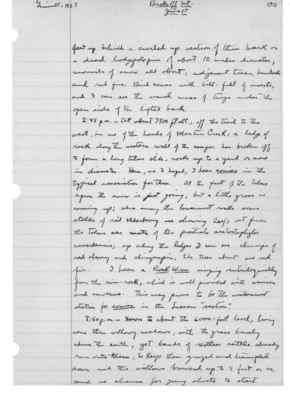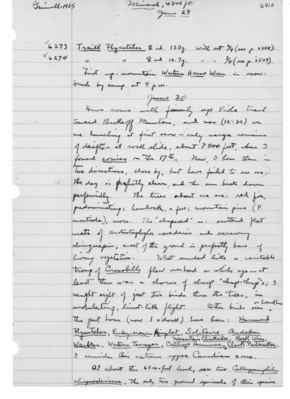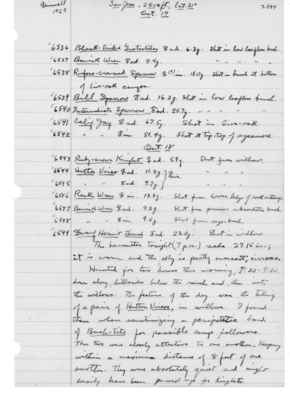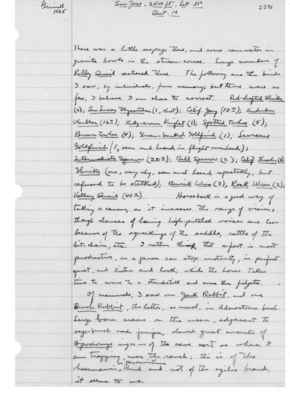Pages That Mention Rock Wren
1925: Joseph Grinnell's field notes
S2 Page 18
Collector: Grinnell - 1925 Location: Lassen Section (Brokeoff Mt.) Date: June 17, 1925 Page Number: 2471
feet up behind a curled up section of thin bark on a dead lodgepole pine of about 10 inches diameter; mounds of snow all about; adjacent trees, hemlocks and red firs. Bird comes with bill-full of insects, and I can see the usual mass of twigs under the open side of the lifted park. 2:45 p.m. - At about 7500 ft. alt.; off the trail to the west, in one of the heads of Martin Creek; a ledge of rock along the western wall of the canyon has broken off to form a long talus slide, rocks up to a yard or more in diameter. Here, as I hoped, I hear conies in the typical association for them. At the fast of the Talus apron the snow is just going, but a little grass is coming up; also among the lowermost rocks some stalks of red elderberry are showing leaf; out from the Talus are mats of the prostrate arctostaphylos nevadensis; up along the ledges I can see clumps of red cherry and chinquapin; the trees about are red fir. I hear a Rock Wren singing ventriloquially from the rim-rock, which is well provided with crevices and caverns. This may prove to be the westernmost station for conies in the Lassen "section." 3:50 p.m. - Down to about 600-foot level, having come thru willowy meadows, with the grass barely above the earth, yet bands of restless cattle already run onto them, to keep them grazed and trampled down and the willows browsed up to 5 feet or so, and no chance for young shoots to start.
S2 Page 57
Collector: Grinnell - 1925 Location: Mineral, 4800 ft. Date: June 29 Page Number: 2510
6273 Traill Flycatcher [female symbol] ad. 13.0 g. with set 3/4 (see p. 2508). 6274 Traill] [Flycatcher] [female symbol] ad. 12.7 g. [with] [set] 3/4 (see p. 2509).
First up - mountain Western House Wren in snow brush by camp at 4 p.m.
June 30 Have come with family up Viola trail towards Brokeoff Mountain, and now (12:30) we are lunching at first snow - only meagre remains of drifts - at rock slide, about 7500 feet, where I found conies on the 17th. Now, I hear them in two directions, close by, but have failed to see one. The day is perfectly clear, and the sun beats down perfervidly. The trees about me are: red fir, predominating; hemlock, a few; mountain pine (P. monticola), more. The "chaparral" is: scattered flat mats of arctostaphylos nevadensis and scrawny chinquapin; most of the ground is perfectly bare of living vegetation. What sounded like a veritable troup of Crossbills flew overhead a while ago - at least there was a chorus of sharp "chup-chup's"; I caught sight of just two birds thru the trees, in undulating, linnet-like flight. Other birds seen ^or heard here the past hour (now 1 o'clock) have been: Hammond Flycatcher, Ruby-crown Kinglet, Solitaire, Audubon Warbler, Western Tanager, Calliope Hummer,^ Mountain Chickadee, Rock Wren, Clark Nutcracker. I consider this extreme upper Canadian zone.
At about 6500-foot level, saw two Callospermophilus chrysodeirus, the only two ground squirrels of this species
S3 Page 51
Collector: Grinnell - 1925 Location: San Jose, 2500 ft., Lat. 31 degrees Date: Oct. 17 Page Number: 2594
6536 Black-Tailed Gnatcatcher (female sign) ad. 6.3g. Shot in low leafless bush. 6537 Bewick Wren (male sign) ad. 8.4.g. 6538 Rufous-crowned Sparrow (male sign)(?) im. 18.0g. Shot in bush at bottom of Live-oak canyon. 6539 Bell Sparrow (male sign) ad. 16.2g. Shot in low leafless brush. 6540 Intermediate Sparrow (male sign) ad. 25.7. Shot in low leafless brush. 6541 Calif. Jay (female sign) ad. 67.5g. Shot in live-oak. 6542 “ “ (male sign) im. 81.4 g. Shot at tip-top of sycamore.
Oct. 18 6543 Ruby-crown Kinglet (female sign) ad. 5.9g. Shot from willow. 6544 Hutton's Vireo (female sign) ad. 11.2g. } Pair “ “ “ 6545 “ “ (male sign) ad. 9.7 g. } Pair “ “ “ 6546 Rock Wren (female sign) im. 13.8g. Shot from lower ledge of rock outcrop. 6547 Bewick Wren (female sign) ad. 9.2g. Shot from prunus subcordata bush. 6548 “ “ (male sign) im. 9.5g. Shot from sage-bush. 6549 Dwarf Hermit Thrush (male sign) ad. 23.0g. Shot in willow.
The barometer tonight (7 p.m.) reads 27.15 in.; it is warm and the sky is partly overcast, cirrous.
Hunted for two hours this morning, 7:30-9:30, down along hillsides below the ranch and then into the willows. The feature of the day was the taking of a pair of Hutton's Vireo, in willows. I found them when scrutinizing a peripatetic band of Bush-tits for possible camp followers. The two were closely attentive to one another, keeping within a maximum distance of 8 feet of one another. They were absolutely quiet and might easily have been passed up for Kinglets.
S3 Page 53
Collector: Grinnell - 1925 Location: San Jose, 2500 ft., Lat. 31 degrees Date: October 19, 1925 Page Number: 2596
There was a little seepage there, and some rainwater in granite bowls in the stream-course. Large numbers of Valley Quail centered there. The following are the birds I saw, by individuals, from memory; but there were so few, I believe I am close & correct. Red-shafted Flicker (2); San Lucas Flycatcher (1, shot); Calif Jay (10±) Audubon Warbler (16±); Ruby-crown Kinglet (1); Spotted Towhee (5); Brown Towhee (4); Green-backed Goldfinch (1); Lawrence Goldfinch (1, seen and heard in flight overhead); Intermediate Sparrow (20±); Bell Sparrow (2); Calif. Thrashers (3); Shrike (one, very shy, seen and heard repeatedly, but refused to be stalked); Bewick Wren (3); Rock Wren (2); Valley Quail (40±). Horseback is a good way of taking a census, as it increases the range of vision, though chances of hearing high-pitched voices are less because of the squeakings of the saddle, rattle of the bit-chain, etc. I rather think that a foot in most productive, as a person can stop instantly, in perfect quiet, and listen and look; while the horse takes time to come to a standstill and even then fidgets. Of mammals, I saw one Jack Rabbit, and one Bush Rabbit, the latter, as usual in Adenostoma bush. Large bare areas in the mesa, adjacent to sage-bush and juniper, showed great amounts of Dipodomys sign — of the same sort as where I am trapping, near the ranch; this is of the heermanni or paramintinus kind and not of the agilis brand, it seems to me.



